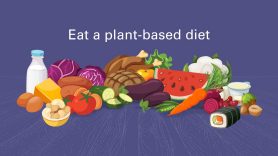A plant-based diet can help lower your cancer risk
Healthy meal planning on a budget
Our expert shows how meal planning can help you make healthier food choices, and save time and money.

If your idea of a meal plan is stopping by the nearest fast-food restaurant on the way home, or grabbing a breakfast sandwich and coffee on the way to work, we get it.
Fast food and packaged food are a cheap and convenient way to get yourself fed between your other commitments.
But if your goal is to eat healthy, save money and save time, consider healthy meal planning.
"Simple planning and prepping ahead can mean you have healthy options available when needed," says Lindsey Wohlford, a wellness dietitian at MD Anderson.
Eating healthy can help you stay lean and reduce your risk for several types of cancer.
Wohlford offers tips on getting started with a healthy meal plan.
Meal planning tools can help you succeed
If you are not a natural planner, sketching out a week of meals may seem like a big challenge. Starting small and using tools can help.
Start by planning out a couple of days for the coming week. You can use a paper or online calendar to list the meals and use that to make a shopping list.

If you want to get more advanced, there are meal-planning apps that can help you come up with ideas, develop shopping lists and stick to a budget. Many of them will let you send your grocery list to a grocery delivery service or directly to the grocery store for online shopping.
Double check the plan is healthy
As a general guide, when planning out your lunches and dinners, aim to fill two-thirds of your plate with non-starchy vegetables, whole grains and fruit. Fill the remaining one-third or less with lean protein or plant-based protein.
For breakfast, aim to have the majority of your meal come from plant-based foods like fruit, whole grain toast or oatmeal.
For snacks, choose a healthy carbohydrate, such as whole grain bread or fruit, combined with a lean protein, like cottage cheese or hummus, or a healthy fat such as nuts. You want to aim for no more than about 200 calories.
What to keep in the pantry
Part of meal planning is using what you already have on hand. If you plan around the ingredients you have, you can save money and waste less food.
Keep your pantry stocked with affordable items that can be used for several meals. That includes canned or dried beans and lentils, grains like brown rice, oatmeal and quinoa, nut butters, canned vegetables, tomato sauce, canned tuna or salmon and whole-grain pasta.
These pantry staples can help you make quick easy meals that are a healthier and less expensive alternative to eating out.
"You can purchase these items in bulk or on sale to cut costs even further," says Wohlford. "These become the foundation of many of your meals so you are automatically ensuring a healthier meal."
Getting your picky eaters on board
If you are meal planning for a family, the task gets a little more complicated. One of the best ways to get picky eaters on board with a meal plan is to include them in the process.
First, explain why you want to make healthy food choices, and how planning meals can help you trim your budget.
Then, ask them to help you design the meals and let them choose some of the options. For example, let them know the meal will include two types of vegetables, and let them choose one of them.
Finally, model healthy behavior by making healthy choices.
Eating healthy is worth the effort
The benefits of eating healthy go beyond long-term reduction in your risk of cancer and other chronic diseases.
"When people start eating healthier they almost always report feeling better, sleeping better, having more energy and having more interest in exercise," says Wohlford.
"If you can take a little time each week to set your life up to have the healthy choice be the easy choice, your wallet and your health will benefit," says Wohlford "Good health doesn’t just happen."
RELATED: 36 foods that can help lower your cancer risk
RELATED: How to choose the best diet
RELATED: How to plan a meal in 6 steps




